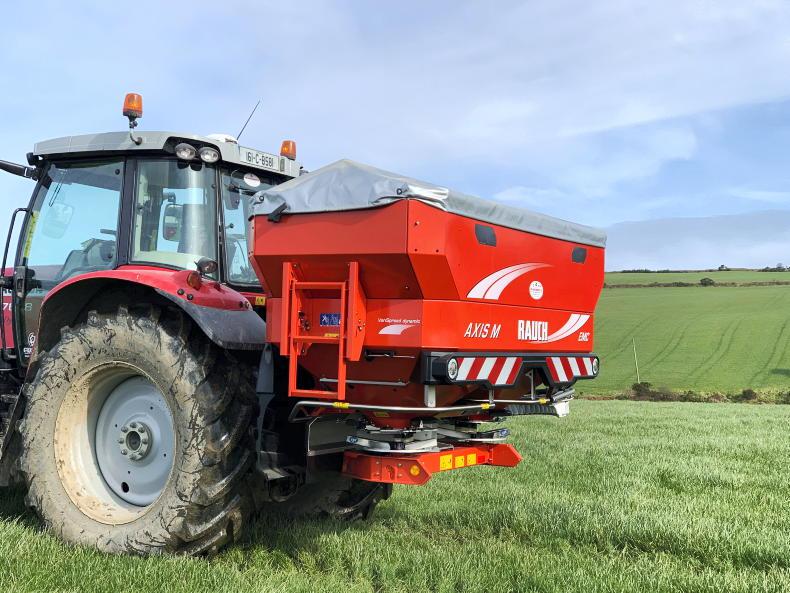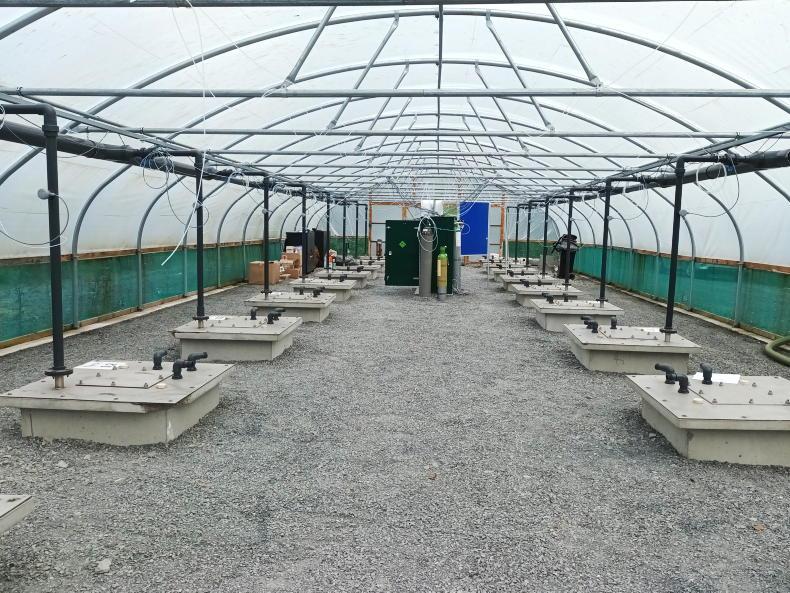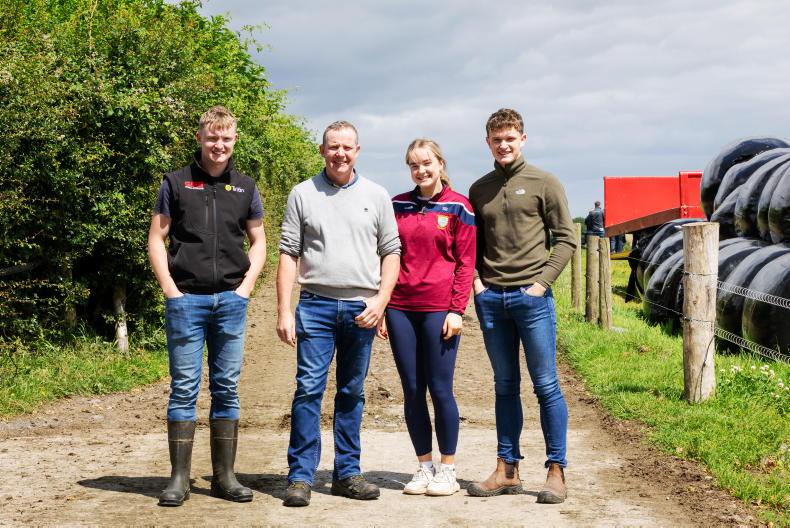The EU Green Deal proposes a 20% reduction in chemical nitrogen (N) fertiliser usage.
If this proposed 20% reduction were to be applied to our current N fertiliser limits, it would reduce our maximum chemical N fertiliser allowances by between 40 and 44 units N/acre.
This raises some serious challenges. Can we reduce our reliance on chemical N fertiliser and maintain current production levels? Could we fill this gap in chemical N fertiliser with other sources of N on our farms? If these changes come into effect, we will have to focus on:
Improving farm N use efficiency.Increasing the N coming from the soil, slurry and clover.Maximising the efficiency of chemical N fertiliser. Improving farm N use efficiency
Nitrogen use efficiency (NUE) is a relatively new concept that will be a key metric. To determine how efficient a farm is at using N, we have to look at how N enters and leaves it.
A farm’s NUE is the proportion of N that enters the farm which leaves the farm in sales, eg milk and calf sales (N outputs ÷ N inputs × 100). Currently, the average NUE on dairy farms is 25% and the industry target is 35%.
Good management of chemical N fertiliser, maximising the use of slurry N, improving soil fertility and having high genetic merit cows that efficiently convert grass to milk solids are some of the main areas that improve NUE.
Increasing the N coming from
the soil, slurry and clover
Soil N: nitrogen released from soil organic matter (SOM) can contribute between 50 and 200 units N/acre/year, with an average of 120 units N/acre/year recorded on permanent grassland soils in Ireland. To maximise soil N release on your farm, it is important that soils are at optimal soil pH (6.3pH to 6.5pH for mineral soil) and index 3 for P and K. This will create a soil environment that allows the soil microbes to work efficiently to release N from SOM for grass growth. Slurry N: there are two practical things that can be done on farms to get more value from the N in slurry:Shift slurry spreading from summer to spring.Change from splash plate to using a dribble bar or trailing shoe (LESS).Spreading slurry with a splash plate in the summer time delivers three units N/1,000 gals of cattle slurry. This can be increased three-fold (nine units N/1,000 gallons) if we change the timing to spring and application method to LESS.
Clover N: white clover can fix between 80 and 120 units N/acre/year. Measurements of white clover N fixation at Teagasc Solohead research farm have found that annual sward clover content is a major driver of the amount of N that clover will supply to the sward. The amount of N supplied by clover fixation is low in spring but increases during early summer and reaches a maximum around July and August, which coincides with increasing sward clover contents.
For this reason, it is recommended to apply chemical N fertiliser to grass/white clover swards in spring to supply N for herbage growth. Chemical N fertiliser applications can be reduced or removed from May/June on, depending on your stocking rate and demand for grass.
Maximising the efficiency of chemical N fertiliser
Know the right fertiliser N allowances for your stocking rate to maximise chemical fertiliser N efficiency.
Spring
On intensive dairy farms, the target for spring is 23 units N/acre in late January/February and 46 units N/acre in March. In many cases, the 70 units N/acre spread by 1 April should not be a blanket approach across the whole farm or on wetter farms. It’s more designed for drier paddocks with good perennial ryegrass content, good soil fertility, good grass covers (>400 kg DM/ha) and warmer/drier ground.
Nitrogen from slurry application should be included in the 70 units N/acre target.
Summer
The aim is to apply a unit of N/day, ie 30 units N/month. The easiest way to do this is match the units N/acre you are spreading to your rotation length. Sulphur application will increase fertiliser N use efficiency. The targets for sulphur are:
15 units S/acre on grazing ground (apply from April to June, eg five units S/rotation). 15 units S/acre on first-cut silage ground. 10 units S/acre on second-cut silage ground (only required on lighter soil types).Autumn
Apply the final chemical N fertiliser in the last week of August instead of waiting until the last few days before the 15 September closing date. This will give a better grass growth response. Apply 25 units N/acre depending on grass supply at the time and check your fertiliser N allowance.
Maintaining current grass production levels using less chemical N fertiliser is going to be one of the major challenges facing dairy farming in Ireland in the near future. Applying the appropriate rates of chemical N fertiliser during the year for your stocking rate, improving soil fertility, spreading slurry with LESS techniques in spring and sowing/promoting clover will all help to meet this future challenge.
The EU Green Deal proposes a 20% reduction in chemical nitrogen (N) fertiliser usage.
If this proposed 20% reduction were to be applied to our current N fertiliser limits, it would reduce our maximum chemical N fertiliser allowances by between 40 and 44 units N/acre.
This raises some serious challenges. Can we reduce our reliance on chemical N fertiliser and maintain current production levels? Could we fill this gap in chemical N fertiliser with other sources of N on our farms? If these changes come into effect, we will have to focus on:
Improving farm N use efficiency.Increasing the N coming from the soil, slurry and clover.Maximising the efficiency of chemical N fertiliser. Improving farm N use efficiency
Nitrogen use efficiency (NUE) is a relatively new concept that will be a key metric. To determine how efficient a farm is at using N, we have to look at how N enters and leaves it.
A farm’s NUE is the proportion of N that enters the farm which leaves the farm in sales, eg milk and calf sales (N outputs ÷ N inputs × 100). Currently, the average NUE on dairy farms is 25% and the industry target is 35%.
Good management of chemical N fertiliser, maximising the use of slurry N, improving soil fertility and having high genetic merit cows that efficiently convert grass to milk solids are some of the main areas that improve NUE.
Increasing the N coming from
the soil, slurry and clover
Soil N: nitrogen released from soil organic matter (SOM) can contribute between 50 and 200 units N/acre/year, with an average of 120 units N/acre/year recorded on permanent grassland soils in Ireland. To maximise soil N release on your farm, it is important that soils are at optimal soil pH (6.3pH to 6.5pH for mineral soil) and index 3 for P and K. This will create a soil environment that allows the soil microbes to work efficiently to release N from SOM for grass growth. Slurry N: there are two practical things that can be done on farms to get more value from the N in slurry:Shift slurry spreading from summer to spring.Change from splash plate to using a dribble bar or trailing shoe (LESS).Spreading slurry with a splash plate in the summer time delivers three units N/1,000 gals of cattle slurry. This can be increased three-fold (nine units N/1,000 gallons) if we change the timing to spring and application method to LESS.
Clover N: white clover can fix between 80 and 120 units N/acre/year. Measurements of white clover N fixation at Teagasc Solohead research farm have found that annual sward clover content is a major driver of the amount of N that clover will supply to the sward. The amount of N supplied by clover fixation is low in spring but increases during early summer and reaches a maximum around July and August, which coincides with increasing sward clover contents.
For this reason, it is recommended to apply chemical N fertiliser to grass/white clover swards in spring to supply N for herbage growth. Chemical N fertiliser applications can be reduced or removed from May/June on, depending on your stocking rate and demand for grass.
Maximising the efficiency of chemical N fertiliser
Know the right fertiliser N allowances for your stocking rate to maximise chemical fertiliser N efficiency.
Spring
On intensive dairy farms, the target for spring is 23 units N/acre in late January/February and 46 units N/acre in March. In many cases, the 70 units N/acre spread by 1 April should not be a blanket approach across the whole farm or on wetter farms. It’s more designed for drier paddocks with good perennial ryegrass content, good soil fertility, good grass covers (>400 kg DM/ha) and warmer/drier ground.
Nitrogen from slurry application should be included in the 70 units N/acre target.
Summer
The aim is to apply a unit of N/day, ie 30 units N/month. The easiest way to do this is match the units N/acre you are spreading to your rotation length. Sulphur application will increase fertiliser N use efficiency. The targets for sulphur are:
15 units S/acre on grazing ground (apply from April to June, eg five units S/rotation). 15 units S/acre on first-cut silage ground. 10 units S/acre on second-cut silage ground (only required on lighter soil types).Autumn
Apply the final chemical N fertiliser in the last week of August instead of waiting until the last few days before the 15 September closing date. This will give a better grass growth response. Apply 25 units N/acre depending on grass supply at the time and check your fertiliser N allowance.
Maintaining current grass production levels using less chemical N fertiliser is going to be one of the major challenges facing dairy farming in Ireland in the near future. Applying the appropriate rates of chemical N fertiliser during the year for your stocking rate, improving soil fertility, spreading slurry with LESS techniques in spring and sowing/promoting clover will all help to meet this future challenge.










SHARING OPTIONS